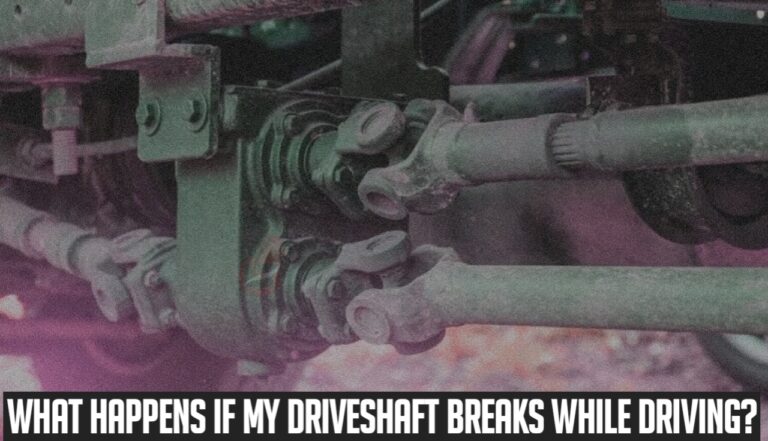The drive shaft plays a crucial role in the vehicle’s smooth operation. It helps to transfer torque and rotational forces to the wheels.
A drive shaft is typically made of steel or aluminum and is designed to withstand high torque and rotational forces. However, it’s susceptible to wear and damage like other mechanical components.
That leads us back to the topic: What happens if my driveshaft breaks while I’m driving? The simple answer is that your wheels will lose power and won’t move because the broken shaft keeps the vehicle in motion.
Although this may not be true when driving downhill, you may hear clunking noises or vibrations depending on the car’s speed. You can check out the symptoms of a bad drive shaft here.
This article will explore the risks associated with a broken drive shaft while driving.
Can I Drive with a Broken Drive Shaft?
No, it would be best if you didn’t drive with a broken drive shaft because you’ll encounter difficulty turning the steering wheel, which may expose you to accidents.
The only driving you should be doing is to park the car safely and seek a towing service.
Although, in most cases, the engine will come on, you will not be able to move the car backward or forward due to the broken shaft.
What Happens if My Drive Shaft Breaks While Driving?
Five things are likely to happen if your drive shaft breaks while driving.
Knowing this will help you understand when to swing into action and what a broken drive shaft feels like.
1. Instant Loss of Control
If you’re driving on the highway and your drive shaft gets broken, there’s a high chance you’ll lose control of your vehicle. This is a repercussion of ignoring the initial symptom of difficulty turning the steering wheel.
Once the driveshaft breaks during acceleration, power transmission to the steering will be lost, resulting in unresponsive or jerky steering.
This incident can cause the drive shaft to drop to the floor, flip the car, pull the car to one side, or, in rare cases, leave the shaft whipping the ground until the vehicle is put in neutral.
2. Inability to Move the Car
Another thing that’ll happen if your driveshaft fails on a leveled surface is that your vehicle will abruptly stop.
When this happens, you won’t be able to move the car forward or backward, nor will you be able to accelerate because the power transmission to the wheels has been lost, reducing the overall power delivery.
3. Clunky or Rattling Noise
You may notice excessive noise from the transmission if the shaft breaks. This is a repercussion for ignoring the clunking sound produced when changing between gears in the past.
4. Sparks or Damage to Other Components
The possibility of the broken shaft hitting other components, which may, in turn, lead to a spark or damage, is very high. For example, the exhaust, the fuel tank, or the wheel bearings.
5. Pose as a risk to road users
In some instances, chunks of the broken driveshaft can fly into the open, causing harm to innocent passersby, which can attract huge fines and charges to you.
What happens if you keep driving on a bad drive shaft?
If you keep driving on a foul drive shaft, either of the below may happen to your vehicle:
- Noise when driving
- Difficulty turning the steering wheel
- Uneven tire wears
- Clanking noise when switching gears
- Car rumbling while accelerating
- Damage to Other Components
- Loss of Power and Control
Remember the above symptoms to help you quickly identify a failing drive shaft and prevent potential accidents.
How Long Can I drive with a broken drive shaft?
I don’t have much to say on this topic since a car with a broken shaft will not move an inch until the shaft is replaced, except for driving downhill.
However, if you want to know how long you can drive on a bad driveshaft, it should be between 150 miles and below, but I promise you the experience isn’t worth it.
Although there are car owners who can comfortably drive with a bad shaft for up to a year, it’s an unsafe practice.
So, once you feel that your steering isn’t responsive or there seems to be a clunking sound when changing gears, quickly take your vehicle to a mechanic for a proper diagnosis and fix.
As an Amazon Service LLC Program Associate, V. Auto Basics earns from qualifying purchases. See Our Affiliate disclaimer.
